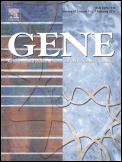 | |
| Discipline | Genetics, molecular biology |
|---|---|
| Language | English |
| Edited by | Marianna Kruithof-de Julio |
| Publication details | |
| History | 1976-present |
| Publisher | |
| Frequency | 42/year |
| 3.5 (2022) | |
| Standard abbreviations | |
| ISO 4 | Gene |
| Indexing | |
| CODEN | GENED6 |
| ISSN | 0378-1119 (print) 1879-0038 (web) |
| LCCN | 77643986 |
| OCLC no. | 614874224 |
| Links | |
Gene is a peer-reviewed scientific journal in genetics and molecular biology, focusing on the cloning, structure, function, as well as the biomedical and biotechnological importance of genes. The scope of the journal includes all biological organisms including viruses, prokaryotes, and eukaryotes. It is organized into topics, which include Human Genetics, Cancer Genetics, Neurogenetics, Animal Genetics, Genome Editing, Molecular Ecology, Plant Genetics, Parasitology and Virology, as well as Microbiology.
Contents
The journal is part of the Gene Family of journals and was established in 1976. It is published by Elsevier and the editor-in-chief is Marianna Kruithof-de Julio (University of Bern) The Gene Family of journals comprises the journals Gene, Gene Reports, Human Gene, and Plant Gene. According to the Journal Citation Reports , the journal has a 2022 impact factor of 3.5. [1]